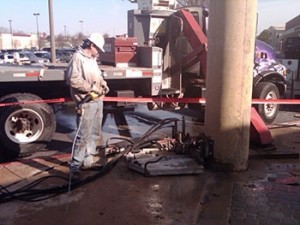When to Begin Concrete Wall Sawing
Wall sawing is a critical step for opening a spot on a wall for a door, a window, or an HVAC unit. Concrete and masonry are the two main materials you might have to saw through. What should you know about how to perform wall sawing, and what are some potential consequences? Here is how you can determine when to begin concrete wall sawing, and what to do once you get started.
How to Begin
First, determine what you need concrete wall sawing for. As mentioned above, creating opens for doors, windows, and HVAC units is just one application for this process. Also be aware that this process uses specific equipment, such as a blade made of diamond, and tracks used to hold the blade in place and guide it while it saws. Concrete walls saws are also known as track saws for this reason. The tracks are often mounted on walls or inclines where a flat slab saw cannot go. Once you are ready to being using concrete wall saws, determine how deep you need the cuts to be. You can cut up to thirty inches on one side of the wall, and thirty inches on the other side. That provides sixty inches total. Whether the sawing calls for an angled cut or not, here’s what else concrete wall sawing can do:
- Creating openings in walls, ceilings, and floors
- Creating openings that are prepared for other fixtures to be installed
- Achieving what is known as a chamfered edge
- Sawing up against the surface
As great as concrete wall sawing is, it’s important to remember what could happen while this sawing is underway.
Consequences of Concrete Wall Sawing
Overcutting is one potential consequence. Overcutting happens when rounded blades are used to go around corners. However, the openings that are created can also be trimmed, and if the how the cut looks when it is finished doesn’t matter, then overcutting isn’t something to be concerned about. However, some openings just cannot have overcutting. One way to avoid overcutting is to attempt a different sawing technique.
Concrete wall sawing is not infallible. There are some situations in which it is impractical. So, in those situations, hand sawing is a possibility. Hand sawing is also known as ring sawing. Hand sawing tools typically run on gas, electricity, or hydraulic power. Their small size lends additional precision, as the hand sawing technique can minimize the chances of an overcut occurring. When overcuts do happen, they can be trimmed with the use of a chainsaw. Regardless of what particular technique is being employed, chain sawing on concrete can also be used to:
- Create openings for electrical and plumbing fixtures
- Open up confined spaces
- Cut beams and pipes
Prioritize Safety with G&M Services
G&M Services is proud of our employees and the dedication they have for safety in the workplace. Our employees are also rewarded for positive safety practices. We incorporate weekly and monthly discussions and meeting to ensure that all involved are aware of how to handle equipment and potential situations that could occur during a project.
G&M Services offers services in the way of concrete drilling and sawing, concrete scanning and FireStop. To get started with us, call today at 410-787-8828 or visit our contact page. Follow the official company page today on Google+, Facebook, Twitter and LinkedIn.









